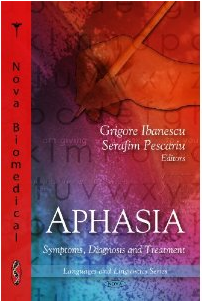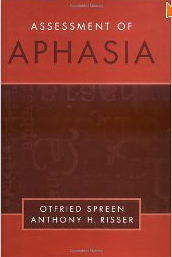Assessment of Aphasia
Spreen and Risser present a comprehensive, critical review of available methods for the assessment of aphasia and related disorders in adults and children. The authors explore test instruments and approaches that have been used traditionally for the diagnosis of aphasia, ranging from bedside screening and ratings, to tests of specific aspects of language, and to comprehensive and psychometrically standardized aphasia batteries. Coverage of other methods reflects newer trends, including the areas of functional communication, testing of bilingual patients, psycholinguistic approaches, and pragmatic and discourse-related aspects of language in everyday life. The authors also examine the expansion of language assessment to individuals with non-aphasic neurological disorders, such as patients with traumatic brain injury, lesions of the right hemisphere, the healthy elderly, and invidulas with dimentia. Taking a flexible and empirical approach to the assessment process in their own clinical practice, Spreen and Risser review numerous test instruments and their source for professionals and students-in-training to choose from in their own use. The introductory chapters cover the history of aphasia assessment, a basic outline of subtypes of aphasia- both neuro-anatomically and psycholinguistically-, and the basic psychometric requirements for assessment instruments. The final part discusses issues in general clinical pracitce, specifically questions of test selection and interpretation.L The book is a thorough and practical resource for speech and language pathologists, neuropsychologists, and their students and trainees.
 Assessment of Aphasia and Related Disorders
Assessment of Aphasia and Related Disorders
 Aphasia Rehabilitation: The Impairment and Its Consequences
Aphasia Rehabilitation: The Impairment and Its Consequences
As a consequence of the disability movement, the thinking generated by the World Health Organization’s classification of disability and functioning, and an upturn in concern for the long-term consequences of aphasia, it has become apparent that two distinctive pathways for the treatment of aphasia have emerged over the past decade. The first (and most traditional) involves assessment and management directed toward lessening the effects of the impairment of aphasia, while the second pathway focuses less on specific language than on the psychosocial consequences of aphasia. This unique text specifically contrasts impairment- and consequences-focused treatment with the aim of providing clinicians with a level playing field that permits them to evaluate for themselves the relative contributions that each approach provides, to evaluate their relative strengths and weaknesses, and finally to seek common ground. An opening chapter sets the scene, while the heart of the book, based on real cases, concerns five meticulously described, yet hypothetical individuals with aphasia. In each of the cases, detailed descriptions and assessment results are provided and clinical management plans, representing each approach, are presented internationally by recognized expert clinicians.
 Language Intervention Strategies in Aphasia and Related Neurogenic Communication Disorders
Language Intervention Strategies in Aphasia and Related Neurogenic Communication Disorders
This thoroughly revised and updated Fifth Edition is the most comprehensive resource on aphasia and related neurogenic communication disorders from the most distinguished authorities of our time. This classic text has been used by graduate speech language pathology students for over 25 years, and continues to be the definitive resource across the speech sciences for aphasia.
The book describes a wide range of intervention strategies including team treatment, group therapy, approaches for bilingual and culturally diverse clients, augmentative and alternative communication, and computer-assisted interventions. An important section addresses psychosocial/functional approaches to intervention. New to this edition are Activities for Discussion that encourage students to reflect on what they just read.
 Aphasia: A Clinical Perspective
Aphasia: A Clinical Perspective
University of California, Los Angeles. A collection of clinical observations from a localizationist perspective of aphasia. Combines both the neurological and the neuropsychological approaches. For neurologists, neuropsychologists, and speech pathologists.
 The Source for Aphasia Therapy
The Source for Aphasia Therapy
WALC 1 Aphasia Rehab
Workbook of Activities for Language and Cognition
 Aphasia: Symptoms, Diagnosis and Treatment (Languages and Linguistics)
Aphasia: Symptoms, Diagnosis and Treatment (Languages and Linguistics)
Aphasia is a language disorder in which there is an impairment (but not loss) of speech and of comprehension of speech. Depending on the area and extent of the damage, someone suffering from aphasia may be able to speak but not write, or vice versa, or display any of a wide variety of other deficiencies in language comprehension and production. This book will review grammatical world class processing by aphasic individuals and bilingual aphasia, each of which is essential to an understanding of the topic. This book will also examine the role of the right hemisphere for language processing and successful therapeutic interventions in aphasic patients. Furthermore, new findings for the understanding of neural processes involved in the recovery of language functions in aphasic subjects are discussed. This book also expands and improves upon the currently accepted methodology used in the diagnosis of dementia, particularly when aphasia is a core symptom. Finally, dual-route models and right-hemispheric accounts are examined to predict comprehension of figurative language in healthy speakers as well as in patients with language disorders.
 A Cognitive Neuropsychological Approach to Assessment and Intervention in Aphasia: A Clinician’s Guide
A Cognitive Neuropsychological Approach to Assessment and Intervention in Aphasia: A Clinician’s Guide
This book provides both a theoretical and practical reference to cognitive neuropsychological approaches to speech and language therapists working with people with aphasia. Having evolved from the activity of a group of clinicians working with people with aphasia, it is a highly practical guide that aims to interpret the theoretical literature as it relates to aphasia and link it directly to available assessment tools and therapy techniques.
The opening section of the book provides an overview of the theory underpinning the approach and how it can be applied to the assessment and interpretation of language-processing impairments. The second section offers a working explanation of different components of language processing, outlining the deficits that may arise from impairment to each component. In addition, the clinician is guided to available assessments to test out clinical hypotheses and offered interpretations of performance patterns. The final section provides a comprehensive overview of the therapy literature with systematic summaries of the therapies undertaken and a synthesis of the findings to date.
This book has been written by clinicians with hands-on experience. It will be an invaluable resource for clinicians and students of speech and language therapy and related disciplines.

